Spanish Expedition And Colonization - Philippine History (1521-1898)
Spanish expeditions and colonization
Although there had been at least two individual European visitors, the first European expedition to explore the Philippine archipelago was that led by Ferdinand Magellan, in the service of the king of Spain. The expedition first sighted the mountains of Samar at dawn on the 16th March 1521, making landfall the following day at the small, uninhabited island of Homonhon at the mouth of the Leyte Gulf. On Easter Sunday, 31 March 1521, at Masao, Butuan, (now in Agusan del Norte), Magellan solemnly planted a cross on the summit of a hill overlooking the sea and claimed possession of the islands he had seen for the king of Spain, naming them "Archipelago of Saint Lazarus". Magellan sought alliances among the natives beginning with Datu Zula, the chieftain of Sugbu (now Cebu), and took special pride in converting them to Catholicism. Magellan"s expedition got involved in the political rivalries between the Cebuano natives and took part in a battle against Lapu-Lapu, chieftain of Mactan island and a mortal enemy of Datu Zula. At dawn on 27 April 1521, Magellan invaded Mactan Island with 60 armed men and 1,000 Cebuano warriors, but had great difficulty landing his men on the rocky shore. Lapu-Lapu had an army of 1,500 on land. Magellan waded ashore with his soldiers and attacked the Mactan defenders, ordering Datu Zula and his warriors to remain aboard the ships and watch. Magellan seriously underestimated the Lapu-Lapu and his men, and grossly outnumbered, Magellan and 14 of his soldiers were killed. The rest managed to reboard the ships. (See Battle of Mactan) The battle left the expedition with too few crewmen to man three ships, so they abandoned the "Concepción". The remaining ships - "Trinidad" and "Victoria" - sailed to the Spice Islands in present-day Indonesia. From there, the expedition split into two groups. The "Trinidad", commanded by Gonzalo Gómez de Espinoza tried to sail eastward across the Pacific Ocean to the Isthmus of Panama. Disease and shipwreck disrupted Espinoza"s voyage and most of the crew died. Survivors of the "Trinidad" returned to the Spice Islands, where the Portuguese imprisoned them. The "Victoria" continued sailing westward, commanded by Juan Sebastián de El Cano, and managed to return to Sanlúcar de Barrameda, Spain in 1522. In 1529, Charles I of Spain relinquished all claims to the Spice Islands to Portugal in the treaty of Zaragoza. However, the treaty did not stop the colonization of the Philippine archipelago from New Spain. After Magellan"s voyage, subsequent expeditions were dispatched to the islands. Four expeditions were sent: that of Loaisa (1525), Cabot (1526), Saavedra (1527), Villalobos (1542), and Legazpi (1564). The Legazpi expedition was the most successful as it resulted in the discovery of the "tornaviaje" or return trip to Mexico across the Pacific by Andrés de Urdaneta. This discovery started the Manila galleon trade, which lasted two and a half centuries. In 1543, Ruy López de Villalobos named the islands of Leyte and Samar "Las Islas Filipinas" after Philip II of Spain. Philip II became King of Spain on January 16, 1556, when his father, Charles I of Spain, abdicated the Spanish throne. Philip was in Brussels at the time and his return to Spain was delayed until 1559 because of European politics and wars in northern Europe. Shortly after his return to Spain, Philip ordered an expedition mounted to the Spice Islands, stating that its purpose was "to discover the islands to the west". In reality its task was to conquer the Philippines for Spain. On November 19 or 20, 1564 a Spanish expedition of a mere 500 men led by Miguel López de Legazpi departed Barra de Navidad, New Spain, arriving off Cebu on February 13, 1565, not landing there due to Cebuano opposition. In 1569, Legazpi transferred to Panay and founded a second settlement on the bank of the Panay River. In 1570, Legazpi sent his grandson, Juan de Salcedo, who had arrived from Mexico in 1567, to Mindoro to punish Moro pirates who had been plundering Panay villages. Salcedo also destroyed forts on the islands of Ilin and Lubang, respectively South and Northwest of Mindoro. In 1570, Martín de Goiti, having been dispatched by Legazpi to Luzon, conquered the Kingdom of Maynila (now Manila). Legazpi then made Maynila the capital of the Philippines and simplified its spelling to Manila. His expedition also renamed Luzon "Nueva Castilla". Legazpi became the country"s first governor-general. With time, Cebu"s importance fell as power shifted north to Luzon. The archipelago was Spain"s outpost in the orient and Manila became the capital of the entire Spanish East Indies. The colony was administered through the Viceroyalty of New Spain (now Mexico) until 1821 when Mexico achieved independence from Spain. After 1821, the colony was governed directly from Spain. During most of the colonial period, the Philippine economy depended on the Galleon Trade which was inaugurated in 1565 between Manila and Acapulco, Mexico. Trade between Spain and the Philippines was via the Pacific Ocean to Mexico (Manila to Acapulco), and then across the Caribbean Sea and Atlantic Ocean to Spain (Veracruz to Cádiz). Manila became the most important center of trade in Asia between the 17th and 18th centuries. All sorts of products from China, Japan, Brunei, the Moluccas and even India were sent to Manila to be sold for silver 8-Real coins which came aboard the galleons from Acapulco. These goods, including silk, porcelain, spices, lacquerware and textile products were then sent to Acapulco and from there to other parts of New Spain, Peru and Europe. The European population in the archipelago steadily grew although natives remained the majority. They depended on the Galleon Trade for a living. In the later years of the 18th century, Governor-General Basco introduced economic reforms that gave the colony its first significant internal source income from the production of tobacco and other agricultural exports. In this later period, agriculture was finally opened to the European population, which before was reserved only for the natives. During Spain’s 333 year rule in the Philippines, the colonists had to fight off the Chinese pirates (who lay siege to Manila, the most famous of which was Limahong in 1574), Dutch forces, Portuguese forces, and indigenous revolts. Moros from western Mindanao and the Sulu Archipelago also raided the coastal Christian areas of Luzon and the Visayas and occasionally captured men and women to be sold as slaves. Some Japanese ships visited the Philippines in the 1570s in order to export Japanese silver and import Philippine gold. Later, increasing imports of silver from New World sources resulted in Japanese exports to the Philippines shifting from silver to consumer goods. In the 1580s, the Spanish traders were troubled to some extent by Japanese pirates, but peaceful trading relations were established between the Philippines and Japan by 1590. Japan"s kampaku (regent), Toyotomi Hideyoshi, demanded unsuccessfully on several occasions that the Philippines submit to Japan"s suzerainty. On February 8, 1597, King Philip II, near the end of his 42-year reign, issued a Royal Cedula instructing Francisco de Tello de Guzmán, then Governor-General of the Philippines to fulfill the laws of tributes and to provide for restitution of ill-gotten taxes taken from the natives. The decree was published in Manila on August 5, 1598. King Philip died on 13 September, just forty days after the publication of the decree, but his death was not known in the Philippines until middle of 1599, by which time a referendum by which the natives would acknowledge Spanish rule was underway. With the completion of the Philippine referendum of 1599, Spain could be said to have established legitimate sovereignty over the Philippines.
Spanish Rule -
Political System
The Spanish quickly organized their new colony according to their model. The first task was the reduction, or relocation of native inhabitants into settlements. The earliest political system used during the "conquista" period was the "encomienda" system, which resembled the feudal system in medieval Europe. The conquistadores, friars and native nobles were granted estates, in exchange for their services to the King, and was given the privilege to collect tribute from its inhabitants. In return, the person granted the "encomienda", known as an "encomendero", was tasked to provide military protection to the inhabitants, justice and governance. In times of war, the "encomendero" was duty bound to provide soldiers for the King, in particular, for the complete defense of the colony from invaders such as the Dutch, British and Chinese. The "encomienda" system was abused by "encomenderos" and by 1700 was largely replaced by administrative provinces, each headed by an "alcalde mayor" (provincial governor) The most prominent feature of Spanish cities was the plaza, a central area for town activities such as the fiesta, and where government buildings, the church, a market area and other infrastructures were located. Residential areas lay around the plaza. During the "conquista", the first task of colonization was the reduction, or relocation of the indigenous population into settlements surrounding the plaza. As in Europe, the church always had control over the state affairs of the colony. The friars controlled the sentiments of the native population and was more powerful than the governor-general himself. Among the issues that resulted to the Philippine revolution of 1898 that ended Spanish rule was the abuse of power by the religious orders.
National Government
On the national level, the King of Spain, through his Council of the Indies ("Consejo de las Indias"), governed through his sole representative in the Philippines: the Governor-General ("Gobernador y Capitán General"). With the seat of power in Intramuros, Manila, the Governor-General was given several duties: he headed the Supreme Court ("Royal Audiencia"), was Commander-in-chief of the army and navy, and was the economic planner of the country. All known executive power of the local government stemmed from him and as vice-regal patron, he had the right to supervise mission work and oversee ecclesiastical appointments. His yearly salary was P40,000. For obvious reasons, the Governor-General was usually a "Peninsular" (Spaniard born in Spain) to ensure loyalty of the colony to the crown.
Provincial Government
On the provincial level, heading the pacified provinces ("alcaldia"), was the provincial governor ("alcalde mayor"). The unpacified military zones ("corregimiento"), such as Mariveles and Mindoro, were headed by the "corregidores". City governments ("ayuntamientos"), were also headed by an "alcalde mayor". "Alcalde mayors" and "corregidores" exercised multiple prerogatives as judge, inspector of "encomiendas", chief of police, tribute collector, capitan-general of the province and even vice-regal patron. His annual salary ranged from P300 to P2000 before 1847 and P1500 to P1600 after it. But this can be augmented through the special privilege of indulto de commercio where all people were forced to do business with him. The "alcalde mayor" was usually an "Insulares" (Spaniard born in the Philippines). In the 19th century, the "Peninsulares" began to displace the "Insulares" which resulted in the political unrests of 1872, notably the execution of GOMBURZA, Novales Revolt and mutiny of the Cavite fort under La Madrid.
Municipal Government
The "pueblo" or town is headed by the "Gobernadorcillo" or little governor. Among his administrative duties were the preparation of the tribute list ("padron"), recruitment and distribution of men for draft labor, communal public work and military conscription (quinto), postal clerk and judge in minor civil suits. He intervened in all administrative cases pertaining to his town: lands, justice, finance and the municipal police. His annual salary, however, was only P24 but he was exempted from taxation. Any native or Chinese mestizo, 25 years old, literate in oral or written Spanish and has been a "Cabeza de Barangay" of 4 years can be a "Gobernadorcillo". Among those prominent is Emilio Aguinaldo, a Chinese Mestizo and who was the "Gobernadorcillo" of Cavite El Viejo (now Kawit). The officials of the pueblo were taken from the "Principalía", the noble class of pre-colonial origin. Their names are survived by prominent families in contemporary Philippine society such as Lindo, Tupas, Gatmaitan, Liwanag, Pangilinan, Panganiban, Balderas, and Agbayani, Apalisok, Aguinaldo to name a few.
"Barrio" Government
"Barrio" government (village or district) rested on the "barrio" administrator ("cabeza de barangay"). He was responsible for peace and order and recruited men for communal public works. "Cabezas" should be literate in Spanish and have good moral character and property. Cabezas who served for 25 years were exempted from forced labor. In addition, this is where the sentiment heard as, "Mi Barrio", first came from.
The "Residencia" and The "Visita"
To check the abuse of power of royal officials, two ancient castilian institutions were brought to the Philippines. The "Residencia", dating back to the 5th century and the "Visita" differed from the "residencia" in that it was conducted clandestinely by a "visitador-general" sent from Spain and might occur anytime within the official’s term, without any previous notice. "Visitas" may be specific or general.
Economy
Manila-Acapulco Galleon Trade
The Manila-Acapulco Galleon Trade was the main source of income for the colony during its early years. Service was inaugurated in 1565 and continued into the early 19th century. The Galleon trade brought silver from New Spain, which was used to purchase Asian goods such as silk from China, spices from the Moluccas, lacquerware from Japan and Philippine cotton textiles. These goods were then exported to New Spain and ultimately Europe by way of Manila. Thus, the Philippines earned its income through the trade of the Manila-Acapulco Galleon. The trade was very prosperous and attracted many merchants to Manila, especially the Chinese. However, initially it neglected the development of the colony"s local industries which affected the Indios since agriculture was their main source of income. In addition, the building and operation of galleons put too much burden on the colonists" annual "polo y servicio". However, it resulted in cultural and commercial exchanges between Asia and the Americas that led to the introduction of new crops and animals to the Philippines such as corn, potato, tomato, cotton and tobacco among others, that gave the colony its first real income. The trade lasted for over two hundred years, and ceased in 1815 just before the secession of American colonies from Spain.
Royal Society of Friends of the Country
José de Basco y Vargas, following a royal order to form a society of intellectuals who can produce new, useful ideas, formally established the Real Sociedad Economica de Amigos del Pais. Composed of leading men in business, industry and profession, the society was tasked to explore and exploit the island"s natural bounties. The society led to the creation of Plan General Economico of Basco which implemented the monopolies on the areca nut, tobacco, spirited liquors and explosives. It offered local and foreign scholarships and training grants in agriculture and established an academy of design. It was also credited to the carabao ban of 1782, the formation of the silversmiths and gold beaters guild and the construction of the first papermill in the Philippines in 1825. It was introduced on 1780, vanished temporarily on 1787-1819, 1820–1822 and 1875-1822 and ceased to exist in the middle of the 1890s.
Royal Company of the Philippines
On March 10, 1785, Charles III created the Royal Philippine Company with a 25 year charter. It was granted exclusive monopoly of bringing to Manila, Philippines; Chinese and Indian goods and shipping them directly to Spain via the Cape of Good Hope. It was stiffly objected by the Dutch and English who saw it as a direct attack on their trade of Asian goods. It was also vehemently opposed by the traders of the Galleon trade who saw it as competition. This gradually resulted into the death of both institutions: The Royal Philippine Company in 1814 and the Galleon trade in 1815.
Taxation
To support the colony, several taxes and monopolies were established. The "buwis" (tribute), which could be paid in cash or kind, with tobacco, chickens, produce, gold, blankets, cotton, rice, or other products depending on the region of the country, was initially fixed at 8 reales, later increased to 15 reales, apportioned as follows: ten reales "buwis", one real "diezmos prediales" (tithe), one real to the town community chest, one real "sanctorum" tax, and three reales for church support. Also there was the "bandalâ" (from the Tagalog word "mandalâ", a round stack of rice stalks to be threshed), an annual forced sale and requisitioning of goods such as rice. Custom duties and income tax were also collected. By 1884, the tribute was replaced by the "cedula personal", wherein everyone over 18 were required to pay for personal identification. The local "gobernadorcillos" wereresponsible for collection of the tribute. Under the cedula system taxpayers were individually responsible to Spanish authorities for payment of the tax, and were subject to summary arrest for failure to show a cedula receipt. Aside from paying a tribute, all male Filipinos from 16 to 60 years old were obliged to render forced labor called “polo”. This labor lasted for 40 days a year, later it was reduced to 15 days. It took various forms such as the building and repairing of roads and bridges, construction of Public buildings and churches, cutting timber in the forest, working in shipyards and serving as soldiers in military expeditions. People who rendered the forced labor was called “polistas”. He could be exempted by paying the “falla” which is a sum of money. The polista were according to law, to be given a daily rice ration during their working days which they often did not receive.
Maura Law
The legal foundation for municipal governments in the country was laid with the promulgation of the Maura Law on May 19, 1893. Named after its author, Don Antonio Maura, the Spanish Minister of Colonies at the time, the law reorganized town governments in the Philippines with the aim of making them more effective and autonomous. This law created the municipal organization that was later adopted, revised, and further strengthened by the American and Filipino governments that succeeded Spanish.
Considering History and Narratives as Spain and the Philippines Approach 501th Anniversary
At the 501th anniversary of the arrival of Spain in the Philippines, which narrative do we celebrate?
Considering History and Narratives as Spain and the Philippines Approach 501th Anniversary
At the 501th anniversary of the arrival of Spain in the Philippines, which narrative do we celebrate?
By: Risa Mabayo, 2 yrs. ago
Considering History and Narratives as Spain and the Philippines Approach 500th Anniversary
An anonymous portrait of Ferdinand Magellan, 16th or 17th century
Credit: Public Domain
On March 16, 2022, we will commemorate the 501th anniversary of the arrival of Europeans in the Philippines. It is a day that means different things to different countries and their peoples.
To the Philippines, that first contact meant an introduction to the Western world, the impetus in the eventual formation of its territorial identity — often a common consequence of empire building — and the beginning of its journey toward nation-building.
To Spain, whose monarch commissioned the voyage that set sail in 1519, this means a celebration of its role in the technological development of nautical science and the will of its leaders to reach previously unknown lands and recreate world geography. It marked the beginning of one of the most powerful empires in history, defined by its maritime force and Catholicism, and one that was to last four centuries.
To the rest of the world, this was arguably a key milestone in the history of globalization; thereafter, the exchange of cultures, ideas, and technology was spurred to unprecedented heights.
Not surprisingly, an eventual disconnect in the narrative surrounding Spanish arrival in the Philippines developed as each country went on to construct their own national identities. In the practice of national myth making, historical events are perused, selected for exclusion or inclusion by storytellers, in this case the states, and then told and retold — proselytized, really — to their respective peoples.
SYNOPSIS OF PHILIPPINE HISTORY
Pre-Spanish Times
There are two theories on the origins of the first Filipinos, the inhabitants of what will later be called the Philippine Islands and eventually the Republic of the Philippines. See the Early Inhabitants of the Philippine Islands.
In the beginning of the 3rd century, the inhabitants of Luzon island were in contact and trading with East Asian sea-farers and merchants including the Chinese. In the 1400's the Japanese also established a trading post at Aparri in Northern Luzon.
In 1380, Muslim Arabs arrived at the Sulu Archipelago and established settlements which became mini-states ruled by a Datu. They introduced Islam in the southern parts of the archipelago including some parts of Luzon and were under the control of the Muslim sultans of Borneo. They had a significant influence over the region for a couple of hundreds years. The Malay Muslims remained dominant in these parts until the 16th century.
Philippine History During the Spanish Colonial Times
In 1521, Ferdinand Magellan, a Portuguese explorer who was serving the Spanish crown, landed in Samar Island on his voyage to circumvent the globe. He explored the islands and named it Archipelago of San Lazaro. Magellan was killed during a rebellion led by a Datu named Lapu Lapu in Mactan Island (adjacent to Cebu Island). Spain continued to send expeditions to the island for financial gain and on the fourth expedition, Commander Ruy Lopez de Villalobos, named the islands: Philippines, after Prince Philip (later King Philip II), heir to the Spanish throne. Spain ruled the Philippines for 356 years.
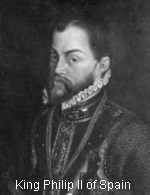
In 1565, King Philip II appointed Miguel Lopez de Legazpi as the first Governor-General of the Philippines. Legazpi chose Manila to be it's capital because of it's natural harbor. Spain's legacy was the conversion of the people to Catholicism and the creation of the privileged landed class. Because of abuses and suppression of the Spaniards, a Propaganda Movement emerged with the aims for equality between Filipinos and Spaniards. The arrest of propagandist Dr. Jose Rizal and execution in 1896 gave fresh momentum to Filipino rebels to fight against Spain.
The secret society of the Katipunan, founded by Andres Bonifacio attacked the Spanish Garrison in San Juan with little success, while Katipuneros in Cavite Province headed by Emilio Aguinaldo defeated the Guardia Civil in Cavite. Aguinaldo's victories lead him to be elected as head of the Katipunan. The factions of Bonifacio & Aguinaldo fought and lead to the trial and execution of Bonifacio on Aguinaldo's orders. Aguinaldo later drafted a constitution and established the Republic of Biak-na-Bato in Bulacan province. In 1897, an impasse between the Spanish government and Aguinaldo arose. After negotiations between the two sides, Aguinaldo accepted an amnesty from the Spaniards and US$ 800,000.00 in exchange for his exile to Hong Kong with his government.
Philippine History During the Japanese Occupation
On December 8, 1941, the Japanese invades the Philippines hours after bombing Pear Harbor in Hawaii. While the forces of
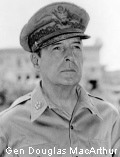
Gen. Douglas MacArthur retreated to Bataan, the Commonwealth government of President Quezon moved to Corregidor Island. Manila was declared an open city to prevent further destruction. After the fall of Bataan on April 9, 1942 and Corregidor, In March 1942, MacArthur & Quezon fled the country and by invitation of
President Roosevelt, the Commonwealth government went into exile to Washington D.C. American and Filipino forces surrendered in May 6, 1942. Soon a guerrilla war against the Japanese was fought by the Philippine & American Armies while Filipinos were enduring the
cruelty of the Japanese military against civilians.
Prior to Quezon's exile, he advised Dr. Jose P. Laurel to head and cooperate with the Japanese civilian government in the hope that the collaboration will lead to a less brutality of the Japanese towards the Filipinos. Rightly or wrongly, President Laurel and his war time government was largely detested by the Filipinos.
In October 1944, Gen. MacArthur with President Sergio Osmeña (who assumed the presidency after Quezon died on August 1, 1944 in exile in Saranac Lake, New York) returned and liberated the Philippines from the Japanese.
The Philippine Republic
On July 4, 1946, Manuel Roxas of the Nationalista Party was inaugurated as the first President of the Republic of the Philippines. Roxas died in April 1948. He was succeeded by Elpidio Quirino. Both Roxas & Quirino had to deal with the Hukbalahap, a large anti-Japanese guerrilla organization which became a militant group that discredited the ruling elite. The group was eventually put down by Pres. Quirino's Secretary of Defense, Ramon Magsaysay.
Magsaysay defeated Quirino in the 1953 elections. He was a popular president and largely loved by the people. Magsaysay died in an airplane crash on March 17, 1957 and was succeeded by Carlos Garcia.
Diosdado Macapagal won the 1961 presidential elections and soon after he changed history by declaring June 12 as independence day - the day Emilio Aguinaldo declared independence in Cavite from Spain in 1898. Aguinaldo was the guest of honour during the fist Independence Day celebrations in 1962.
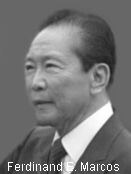
Philippine History During the Martial Law Regime
Ferdinand E. Marcos won the presidency in 1965 and was the first president to be re-elected for a second term in office. Marcos He embarked on an ambitious public works program and maintained his popularity through his first term. His popularity started to decline after his re-election due to perceived dishonesty in the 1969 campaign, the decline in economic growth, government corruption and the worsening peace & order. He declared Martial Law in 1972 near the end of his second & final term in office. Staunch oppositionist, Senator Benigno "Ninoy" Aquino (later went on self exile to the U.S.) & Senator Jose Diokno were one of the first to be arrested. During the Martial Law years, Marcos held an iron grip on the nation with the support of the military. Opposition leaders we imprisoned and the legislature was abolished. Marcos ruled by presidential decrees.
Post Martial Law up to the Present Time
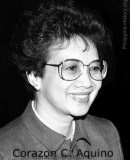
The 21-year dictatorial rule of Marcos with wife Imelda ended in 1986 following a popular uprising that forced them to exile to Hawaii. Corazon "Cory" Aquino, the wife of exiled and murdered opposition leader Benigno Aquino who was perceived to have won a just concluded snap election was installed as president. Aquino restored civil liberties, initiated the formation of a new constitution and the restoration of Congress.
On September 16, 1991, despite the lobbying of Aquino, the Senate rejected a new treaty that would allow a 10-year extension of the US military bases in the country.
In the1992 elections, Pres. Aquino endorsed Secretary of Defense Fidel Ramos as her successor, which Ramos won with a slight margin over his rival, Miriam Defensor-Santiago. During the Ramos presidency, he advocated "National Reconciliation" and laid the ground work for the resolution of the secessionist Muslim rebels in the southern Philippine Island of Mindanao. The Moro National Liberation Front (MNLF) led by Nur Misuari, signed a peace agreement with the government. However a splinter group, The Moro Islamic Liberation Front (MILF) led by Hashim Salamat continued to fight for an Islamic state. Ramos worked for the economic stability of the country and the improvement of the infrastructure facilities like telecommunications, energy and transportation.
Joseph Ejercito Estrada, a popular actor, succeeded Ramos in 1998 with Gloria Macapagal-Arroyo (daughter of former President Diosdado Macapagal) as his Vice-President. Estrada's lack of economic & management skills plunged the economy deeper as unemployment increased and the budget deficit ballooned. In October 2000, Estrada's close friend Luis "Chavit" Singson accused Estrada of receiving millions of pesos from "Jueteng", an illegal numbers game. Soon after, Congress impeached Estrada on grounds of bribery, graft and corruption, betrayal of public trust and culpable violation of the constitution. His impeachment trial at the Senate was however blocked by his political allies in the Senate. Shortly after the evidence against Estrada was blocked at the Senate, thousands of people rallied up at the EDSA Shrine, site of the People Power Revolution which ousted Marcos in 1986.
In January 2001, the Supreme Court declared Joseph Estrada unable to rule in view of mass resignations from his government and declared Vice-President Gloria Macapagal-Arroyo as his constitutional successor. To this date, Estrada remains detained facing graft charges before the Sandigan Bayan, the Anti-graft court.
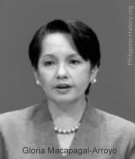
Gloria Macapagal-Arroyo, completed the remaining term of Estrada and run for re-election against Fernando Poe, Jr., another popular actor and a friend of Estrada in May 2004. Arroyo with her running mate Noli de Castro was eventually proclaimed the winners of the Presidential & Vice-Presidential elections. She has been advocating a change from a Presidential form of government to a Parliamentary form of government.
Arroyo's husband & son has been rumored to be receiving money from gambling lords and this has tainted her reputation. A tape recording of Arroyo talking with a commissioner on elections surfaced establishing impropriety by Arroyo and suggesting that she might have influenced the outcome of the last elections. Demonstrations followed in June 2005 calling for Arroyo to resign.
On the eve of the anniversary of the "People Power Revolution" on February 24, 2006, the government took pre-emptive measures to quash alleged plots to unseat Arroyo through massive rallies and a coup. Arroyo declared a "State of Emergency" the next day mobilizing the police and the military averting any destabilization moves. Note: Arroyo is has been under hospital arrest since 2011 for charges of electoral sabotage and misuse of public funds. She is detained at the Veterans Memorial Hospital in Quezon City, Metro Manila.
May 14, 2007 - National Elections for Senators, Congressmen, Governors, Mayors and local officials. Although there are instances of violence and allegations of cheating specially in Mindanao, this elections is considered by many as one of the most peaceful elections conducted in Philippines.
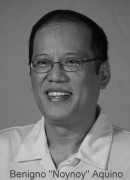
September 12, 2007 - Former President Joseph Ejercito Estrada is convicted of plunder by the Sandiganbayan, the anti-graft court and is sentenced to 40 years imprisonment. He is the first former president ever convicted of any crime in Philippine history. Six weeks later, on October 26, Estrada was pardoned by President Arroyo. Because of the pardon, Estrada was able to run for Mayor of Manila and won. He is presently the city mayor of Manila.
Benigno Simeon Cojuangco Aquino III, affectionately called "Noynoy" and "Pnoy", a former senator is the son of former President Corazon C. Aquino and the late Senator Benigno Aquino. He won the May 10, 2010 presidential elections and was proclaimed president on June 30, 2010 at Rizal Park in Manila. Former President Gloria Arroyo, was elected congresswoman for the second district of Pampanga. This
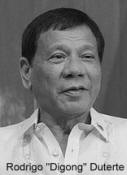
was the first computerized national elections in Philippine history. Aquino is generally perceived as honest with high public satisfaction ratings. Under his presidency, the Chief Justice of the Supreme Court, Renato Corona was impeached in 2011 for non-declaration of assets and prominent politicians like Senators and Congressmen is being charged of corruption. Aquino continues his anti-corruption crusade. Under the present constitution, Aquino cannot run for a second term. Presidential elections were held in May 9, 2016. Strong candidates were Mary Grace Sonora Poe-Llamanzares, Rodrigo Roa Duterte, Manuel "Mar" Araneta Roxas II and Jejomar Cabauatan Binay.
- Adjacent
- Airplane Crash
- Ambitious
- Amnesty
- Bases
- Bases Military
- Constitution
- Agreement
- Filipino
- Abuses
- Adjacent
- Airplane Crash
- Ambitious
- Amnesty
- Bases
On June 30, 2016, Rodrigo "Rody" Roa Duterte (a.k.a. Digong), the former mayor of Davao City in Mindanao who is known for his strong stance against illegal drugs and crime, assumed the presidency succeeding Benigno Aquino III after receiving an overwhelming win in the May 9 elections. On the same day but separately, former congresswoman Maria Leonor "Leni" Santo Tomas Gerona-Robredo (Leni Robredo for short) who belongs to a different party, takes oath as vice-president succeeding Jejomar Binay. Both Duterte & Robredo serves a single term limit of six-years (till 2022). Duterte is advocating a change of government from presidential to a federal form of government. Unlike previous presidents, the tough-talking Duterte is antagonistic towards the United States, which has been a long time ally of the Philippines. Remarkably, he is more friendly with China, a country which the previous administration filed a case against at The Permanent Court of Arbitration in The Hague for occupying several islands within the Philippine 200 mile exclusive economic zone. The court decided overwhelmingly in favor of the Philippines in July 2016, China refuses to accept the verdict. Duterte has been criticized by human rights groups and some in the international community for his hard handed tactics against illegal drugs which has lead to the killings of thousands (including innocent bystanders) allegedly involved in the drug trade.
On March 10, 2020, due to the worldwide spread of the Novel Coronavirus (officially named COVID-19), Duterte has declared a public health state of emergency in the Philippines. The virus which was first discovered in Wuhan, China. To slow the number of infections and fatalities, Metro Manila and later the whole island of Luzon has been placed under lockdown. The total number victims of COVID-19 has yet to be determined. In March 2021 the government started inoculating a vaccine against Covid-19 staring with health care workers.
Visit our Main Web Page with a List of other Philippine based websites:
© Copyright 2022 | All Rights Reserved
Privacy Policy


 Philippine History During the Martial Law Regime
Philippine History During the Martial Law Regime










